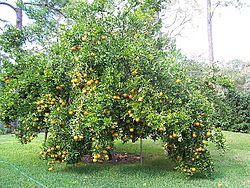Ponkan facts for kids
Quick facts for kids Ponkan |
|
|---|---|
 |
|
| Ponkan tree, Florida | |
| Scientific classification | |
| Kingdom: | |
| (unranked): | |
| (unranked): | |
| (unranked): | |
| Order: | |
| Family: | |
| Genus: | |
| Species: |
C. poonensis
|
| Binomial name | |
| Citrus poonensis |
|
The Ponkan (also called "Chinese Honey Orange") is a type of sweet Citrus fruit. It is a large fruit, about the size of an orange. The Ponkan is a mix of two other citrus fruits: a mandarin and a pomelo.
What is a Ponkan?
The name "Ponkan" comes from "Poona orange," which was the original type of this fruit. "Kan" means citrus fruit.
The Ponkan fruit is very sweet and round. It is usually about 7 to 8 centimeters wide.
Ponkan trees often produce a lot of fruit every other year. Sometimes, the branches can even break because of how much fruit they carry! Growers sometimes use sticks to hold up the heavy branches.
How Ponkan Trees Grow
You can grow Ponkan trees from their seeds, as they usually grow true to type. They can also be grown by grafting them onto other plants. A common plant used for grafting is the trifoliate orange.
In the early 1900s, a person named Andrew Willis helped make the Ponkan fruit very popular in Florida, USA.
One cool thing about Ponkan fruit is that its skin is very loose. This makes it super easy to peel!
Where Ponkans are Grown
Ponkans are grown in many places around the world. You can find them in the United States, Brazil, Japan, and China.
In Taiwan, Ponkan is a very important fruit. It is often grown as a special, high-quality fruit. Taiwan exports many Ponkans to places like Hong Kong, Japan, and Canada.
The Ponkan fruit first came to the United States in 1880. Carlo Roman brought it over. His original fruit grove in Florida is still producing Ponkans today!
In Brazil, the city of Teresópolis even has a yearly festival just for the Ponkan fruit.
See also
In Spanish: Ponkan para niños

